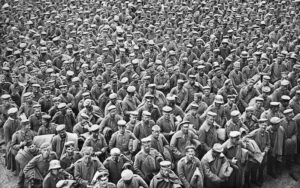Forgotten Friday – Battle of Ameins
Battle of Amiens, (8th – 11th August, 1918), was a World War One battle that marked the beginning of what came to be known as the “hundred days,” a string of Allied offensive successes on the Western Front that led to the collapse of the German army and the end of the war.
By late July 1918 Allied forces held a superior position on the Western Front; troops from the United States were pouring in to reinforce the war effort, and German soldiers were exhausted in the wake of a stalled offensive on the Marne. Having gained the initiative, Allied commanders had hoped to launch a limited offensive to secure a series of strategic transit hubs. As part of this, French General Ferdinand Foch planned an attack in the Amiens region of northern France that would protect the vital Paris-Amiens railway.

(c) q_9271 Imperial War Museum
On 8th August at 4:20 AM, over 900 Allied guns opened fire and the infantry headed toward the German lines. The Germans were entirely unprepared for an attack of this size, and many surrendered at the first chance. Allied soldiers fought through woods to clear German machine gun positions and take prisoners. The tanks lagged behind, struggling across the boggy terrain, leading to a lot of the battle fought on foot. Allied forced advanced over 11 kilometres (7 Miles) on the first day of the battle!
The battle ended on 11th August as German resistance stiffened and Canadian commander Sir Arthur Currie urged the Allied leadership to consolidate the gains they had made thus far. More than 19,000 Allied soldiers were killed or injured, while the Germans lost more than 26,000, including 12,000 prisoners. Also captured by the Allies was the “Amiens gun,” a 280-millimetre (11-inch) Krupp naval gun that had been mounted on a railway carriage. The “Amiens gun” had been shelling the city of Amiens throughout the summer, and previous attempts to disable it had been unsuccessful, but an enterprising Australian sapper commandeered the train’s engine and drove it back to Allied lines.
Ludendorff described the opening day of the battle as “the black day of the German Army in the history of this war…Everything I had feared, and of which I had so often given warning, had here, in one place, become a reality.” When Ludendorff informed German emperor William II of the disaster at Amiens, William replied, “We have reached the limits of our capacity. The war must be terminated.” Indeed, Amiens sparked the “hundred days” campaign, the successful Allied push that would drive the Germans backwards until their ultimate defeat and the signing of the armistice on November 11, 1918.[1]

A British corporal stands beside his camouflaged Mark V tank. Allied tanks were tasked with punching through the barbed wire and destroying German machine guns. https://warfarehistorynetwork.com/article/canadian-valor-at-the-battle-of-amiens/
Copyright too: [1] https://www.britannica.com/event/Battle-of-Amiens read more here!

